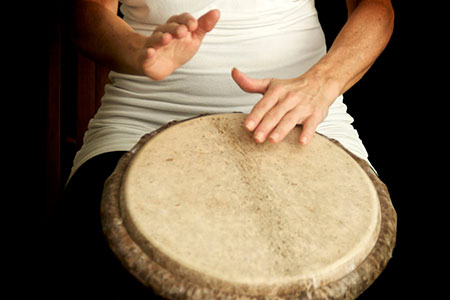spiritual practice
Paranormal Activity, Or Energy Residue?
 Clients sometimes ask me to do an energy clearing in their homes or businesses. In have even been asked to do a cleansing in stables, where the horses had been inexplicably out of sorts and acting out of character. The energy clearing methods I use vary from the more typical Western techniques to traditional African methods that I learned while living there.
Clients sometimes ask me to do an energy clearing in their homes or businesses. In have even been asked to do a cleansing in stables, where the horses had been inexplicably out of sorts and acting out of character. The energy clearing methods I use vary from the more typical Western techniques to traditional African methods that I learned while living there.
One of the most memorable clearings I ever did was for a long-standing client who struggled with a deep sense of guilt over the suicide of her late husband. She had asked me to do an energy clearing ritual in her home, to see what I could pick up.
Her husband had ended his life sitting in a large, plush wingback chair in their home, where they were bringing up their two young children. Apparently, they had argued a lot in the weeks leading up to his death, particularly after he’d discovered her affair with another man.
Guilt overwhelmed her, and her late husband’s family made their judgment of her very clear. They felt his passing was her fault.
In a mediumship reading I did for her, her late husband had come through with messages that proved he had crossed over to the Other Side, that he was at peace, and that she was never to blame for him choosing to depart from this life. Instead, he spoke of his own life-long battle with depression, and his personal failures in their broken marriage.
The mediumship validations were however not enough to ease my client’s haunting feelings of guilt. She was convinced that her husband’s troubled spirit was haunting their home, and she insisted on me doing an energy cleansing. She was, however, not keen on some of the more typical Western clearing methods, nor the shamanic African approaches I offered, so I suggested we simply use some sage incense and prayer, and she was satisfied for me to do so.
She also consented to me having free access to every nook and cranny of the house, because it is often surprising where energy disturbances can reside. She believed there was a heavy, dark cloud of negative energy around that wingback chair, but to my surprise, there was nothing! In fact, the whole room was clear of any negative vibrations. Continue reading
To The Beat Of My Own Drum
 I am in the process of moving home. While going through years of stored stuff in the attic of my old home, I found a Christmas gift that my parents gave me around the age of four. It was a little drum, intact, with sticks to play to the beat of my young heart. I am sure there were many times my parents thoroughly regretted buying a four-year-old a drum to bang on!
I am in the process of moving home. While going through years of stored stuff in the attic of my old home, I found a Christmas gift that my parents gave me around the age of four. It was a little drum, intact, with sticks to play to the beat of my young heart. I am sure there were many times my parents thoroughly regretted buying a four-year-old a drum to bang on!
To my surprise, throughout the house, I also found a total of eleven more drums. All different sizes and kinds. And it is safe to say I can still make a joyful noise with each one (although my family might consider this debatable).
In the summer we spend a lot of time at Camp Etna, one of the spiritualist camps here in Maine. We have two small cottages here – one that we live in, and another I use as my office. Some of the drums I found are kept in the office cottage, for my clients to enjoy.
Why the obsession with drums, you may ask? Well, drumming has always been a form of great stress relief for me. You can release pent up emotions, by beating the drum as hard or soft as you wish. It feels good to express yourself through the primal beat. Moving to the sound of the beat seems to make doing most tasks easier. Drumming is just plain old-fashioned fun, and people around the world have been moving to the sound of drums since the beginning of time.
Drums are also a very useful spiritual tool. In energy work, for example, I use drums to get in touch with the heartbeat. We also host a drumming circle here, at least once a week. Young and old come out to participate, and everyone in the area is invited. It is a spiritual activity that helps to unite the community. One person sets the intention, and the beat for the circle, and then all join in. It is wonderful to see the smiles and joy the drumbeat brings to faces.
Anyone can learn to play the drum. With people being at home much more these days, if you have always had the desire to learn to play and instrument, it is a good time to try the drums. With all the information technology we have these days, there are many courses and tutorials available online for one to learn drumming techniques in the comfort of your home.
Invoking The Angels Of Abundance
 True abundance and well-being is the natural state of the human soul. We are meant to dwell in abundance and well-being, because we live in an abundant, harmonious universe.
True abundance and well-being is the natural state of the human soul. We are meant to dwell in abundance and well-being, because we live in an abundant, harmonious universe.
However, there are some people that constantly dwell in lack consciousness and a scarcity mentality, which is then reflected in the lives they live. This will often emerge through the negativity and judgments they have about their circumstances, as well as their endless criticism and envy of others.
Angelic energy allows us to move from this mindset of limitation and lack into the true abundant flow of the Universe.
Sometimes people confuse ‘abundance’ with the collection of wealth, prosperity and material things. Yes, collecting these things can be one aspect of abundance, but true abundance is way more than just material prosperity.
True abundance is to have enough of all that we need to accomplish our higher purpose and fulfill our spiritual destiny. This includes many other valuable things, beyond money and material comforts, such as enough time to reach our goals; a healthy work-life balance; nurturing relationships; good health; adequate energy and vitality; a sense of purpose; spiritual wisdom and authentic living; and lots of love, happiness and joy. These are the true luxuries of life!
An angel of abundance helps us to get into the flow of abundance, and help us understand that abundance is meant to flow. No wonder we refer to money as “currency.” The very name that we use to define our medium of trade in this reality, has its root in flow. An angel of abundance is therefore not so much about delivering lots of material stuff to us, but more about awakening us to the natural flow of life and our true spiritual purpose in this lifetime.
The Healing Embrace Of Mother Nature
 Throughout my life, especially during the most difficult times, the one thing I have always been able to count on is Mother Nature. Gaia, the Great Mother, has always served me well.
Throughout my life, especially during the most difficult times, the one thing I have always been able to count on is Mother Nature. Gaia, the Great Mother, has always served me well.
I grew up in California, where there is an abundance of water: water falls, creeks, rivers, lakes and the spectacular Pacific Ocean. I had quick and easy access to hiking paths, and other adventures and recreational activities in the great outdoors. In fact, next to dance, hiking was my favorite form of exercise in my teenage years.
When times are difficult, I have always sought out nature. It is so much easier to block out other people’s negativity when all you can see is God’s magnificent creation. It’s divine intent, joy, beauty, harmony, balance, and timelessness.
In the arms of Mother Nature, there is the freedom to tune out all the noise and toxic energy of others…and just hear the voice of Go. It helps you to center yourself, and clear out the negative energy and drama other people sometimes bring into your life.
I find that those of us who live in large cities and urban areas are more likely to get swallowed up by the negative energy of others. We can simply not get away from it in our daily lives. Going back to a home every day, where there is still a lot of radiation and traffic noise, will not let you heal or reenergize.
We all need to take the time to hear our inner voice. No cars, no talking, no noise. Just our own thoughts and inner guidance. We must make time to just hear the voice of spirit within. Otherwise, the voice of the ego that we hear in our head becomes toxic with negative self-talk.
God’s natural world is a temple of healing, a shrine of grace, a sanctuary for the burdened soul. This is why nature must also be protected. By protecting nature, we are protecting God. Mature is a gift to us from Source. It belongs to all of us, including future generations.
How Sticky Notes Can Change Your Life
 We live in a world where we are bombarded with negativity every day. Whether it comes from social media or the mainstream news, it’s easy to feel like you’re drowning in a sea of negative information and fear-based messages. And the more we are exposed to all this negative input, the more we internalize it, until it becomes part of our self-talk and general state of mind.
We live in a world where we are bombarded with negativity every day. Whether it comes from social media or the mainstream news, it’s easy to feel like you’re drowning in a sea of negative information and fear-based messages. And the more we are exposed to all this negative input, the more we internalize it, until it becomes part of our self-talk and general state of mind.
Fortunately, the solution to some of life’s most complex challenges can often be found in the most mundane. Enter the simple sticky note! By writing down simple, positive affirmations or slogans on a bunch of sticky notes, and placing them anywhere you will see them frequently, you can significantly change your inner dialogue from constant negativity and nay-saying to one of possibility, hope and optimism.
Choose simple, short affirmations that resonate with who you are, and what you truly want in life. Whether it’s something like, “I am worthy,” or “Love surrounds me,” or even, “I will get that dream job,” it will inspire you to change the narrative and negative self-talk each time you read one of these short statements out loud.
This technique always reminds me of the famous opening scene of the television cartoon, The Simpsons, with Bart Simpson writing a phrase over and over on the chalkboard. There’s actually some method in the madness of this old-fashioned way of disciplining schoolkids. When our brain repeats a word or phrase over and over again, new neural pathways are created with new associations. Saying something once or twice only, we’re just as likely to forget it. But if it’s something we repeat many times, our brain will literally change over time, and so will our patterns of thought, feeling and action.
It’s been shown that establishing a new habit, or making new behavior automatic, takes on average about two months. Try placing your sticky notes in those places you spend most of your time every day: in your workspace, your car, on the bathroom mirror, the kitchen refrigerator, or on your bedside table. The more you see (and repeat) the words written on them, the more you will start to transform your thinking.
Astral Travel To Your Favorite Destination
 Traveling to sacred sites has always been something I love doing, ever since I was a young girl. There is something undeniably magical about visiting a spiritual place that has much lore or mystical history associated with it. Some of my favorite destinations include Mount Shasta in Northern California, Sedona in the Verde Valley of Arizona, and Machu Picchu in the Andes Mountains in Peru.
Traveling to sacred sites has always been something I love doing, ever since I was a young girl. There is something undeniably magical about visiting a spiritual place that has much lore or mystical history associated with it. Some of my favorite destinations include Mount Shasta in Northern California, Sedona in the Verde Valley of Arizona, and Machu Picchu in the Andes Mountains in Peru.
These sacred sites are all home to powerful energy vortices and ley lines in the Earth’s electromagnetic field, containing more metaphysical energy than ordinary places. Visiting here feels as though you have stepped into a different dimension, or another place in time. Millions of people around the world travel to these locations in search of enlightenment and healing, gaining a broader perspective, raising their awareness, or simply to have a special spiritual experience.
With the advent of Covid-19, few people have had the luxury lately of air travel and long-distance trips. Many spiritual travelers are feeling frustrated and trapped. Some are going stir crazy not having the freedom to travel anywhere in the world. Even local excursions and short-distance trips are challenging these days. I enjoy traveling in the Mount Shasta area, for example, since it is not too far from where I live, but I am reluctant to stay over in a hotel during this time.
However, spirit recently reminded me that I could still travel to my favorite sacred sites by way of the astral realm. It made me think of the Celtic concept of the immram, which refers to the taking of a soul journey, a sacred pilgrimage, a wonder voyage to a sacred site where the soul needs to go. Spiritual seekers and metaphysicians have been taking these inner voyages on the astral plane through the ages.
We are not limited to the physical body or the mundane world. In the same way we can physically visit a physical place of interest, we can also journey there on the astral plane. Traveling in this way, we can journey anywhere we want to, while remaining in the physical comfort of our own home.
Your Eternal, Beautiful Soul
 We are not just a physical body. We are spiritual beings and our soul is ageless and eternal. It never comes to an end. The soul is energy and merely takes on different forms. For energy cannot be destroyed, only transformed.
We are not just a physical body. We are spiritual beings and our soul is ageless and eternal. It never comes to an end. The soul is energy and merely takes on different forms. For energy cannot be destroyed, only transformed.
Your soul is currently manifested in a physical body, but you are not your body. Your soul is who you really are, the very core of your existence.
It is my belief that the soul chooses many new and different experiences as a physical manifestation, each time it decides to incarnate. Some of these physical experiences are very joyful and fulfilling, while other can be very challenging and evolutionary.
Many of us consider ourselves to be ‘old souls.’ An old soul is basically a person that seems to have deep wisdom, unusual insight, or profound compassion from their early childhood. As children they are often said to be ‘wise beyond their years.’
Old souls are often what others may call ‘the voice of reason.’ They tend to see all sides of a situation, or know just the right thing to say to help others with guidance, without dictating to them which path to take.
Most people are conscious of taking care of their body and mind, but not so much about taking the time to nurture their soul. To this day many scientists and medical experts still do not associate physical health and well-being with the mind-body-soul connection. Adding the soul to the wellness equation creates the best medicine possible, in my opinion.